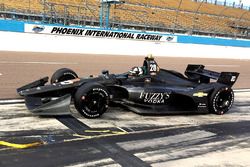2021 IndyCar plans to be resolved late next year
IndyCar will have decided by next fall whether to extend the 2018 car’s planned life for an extra season, or start over with a brand new car in 2021.

Photo by: IndyCar Series











IndyCar’s current IR12 chassis – originally referred to as the DW12 in honor of its main test driver, two-time Indy 500 winner Dan Wheldon – first took the green flag in the opening round of the 2012 IndyCar season. Although it has received several upgrades in that time, including extra anti-intrusion panels around the cockpit, and is about to enter its third era of bodywork, the basic design will have still served nine years by the end of 2020.
However, both IndyCar and Dallara are open to possibly extending this by a year, so that its all-new replacement may not arrive until 2022. Ahead of the introduction of Dallara’s new universal aerokit, Jay Frye, president of competition and operations at IndyCar, told Motorsport.com this matter should be resolved by the next off-season.
“The car is locked in for 2018, ’19, ’20,” he said. “At some point do we put the stake in the ground and say 2022 is when we’re going to have a completely new car? We might just go, ‘Hey this car, we’re just getting started with it, everybody likes it, it looks right, do we just extend this thing for one year?’
“In May we’ll start to talk about a new car for 2021 or ’22, and then, by the fall, we should know what we’re going to do in ’21 and then we go forward.
“There’s got to be a process to that too when that comes, so that it all fits together.”
Dallara says it has sold a significant number of IR12s in the off-season because of IndyCar’s stability in guaranteeing the car will be used for at least another three seasons.
Andrea Toso, Dallara’s head of R&D and US racing programs, says that it will discuss the 2021/2 car once it is confident the new 2018 aerokit has met its goals.
“I would say we start looking after Indy 2018 [at a new car],” he said. “We have to check all the stuff with IndyCar on road courses, street courses and speedways and once we’re happy with all that we look at a new car.”
Toso also implied that the arrival of new teams, thereby increasing the demand for chassis, would help keep the costs of new cars at a reasonable level.
“The plan is to improve IndyCar and to have more cars on the grid, and you get that with new teams coming like Juncos, Harding and Carlin. These are great additions and if we can make the car number up to say 24 or 26 cars, then we can afford new cars.
“Whenever [IndyCar] introduces a car it’s a big investment, big money spent, and you have a difficult time. Now is the time to be stable, increase the car count and see where we stand three years from now.”
Hunt for third OEM ongoing
Frye reiterated the fact that bringing in a third manufacturer alongside Chevrolet and Honda remained a “huge goal.”
Honda and Chevrolet recently signed contract extensions with the series, but both companies are keen to see IndyCar add a third. Frye described the talks as positive, and again said the deletion of manufacturer of aerokits had removed a major hurdle.
“Another OEM partner is a huge goal of ours,” he said. “They all have a three, a five or a 10-year plan. We can go to them and say: ‘Here’s our plan, here’s where we’re going forward, here’s how it’s going to work’. I think they appreciate that.
“I think the [manufacturer] aerokit … eliminated a lot of them. They weren’t really interested in being part of the process.
“So a [new spec aerokit] was step one, step two is the plan, they see that. There’s been enthusiasm and they’re curious about what we’re doing. I was surprised by how much they know about what we’re doing, which is another good indicator that they’re paying attention.
“This doesn’t mean that any of them are coming for sure, but there’s a couple that I would say are active and we’re encouraged by.”
IndyCar believes a third manufacturer could join in 2020, although a prospective party would have to make its intentions clear by “early summer”.
Be part of Motorsport community
Join the conversationShare Or Save This Story
Subscribe and access Motorsport.com with your ad-blocker.
From Formula 1 to MotoGP we report straight from the paddock because we love our sport, just like you. In order to keep delivering our expert journalism, our website uses advertising. Still, we want to give you the opportunity to enjoy an ad-free and tracker-free website and to continue using your adblocker.














Top Comments